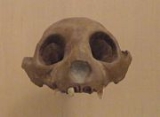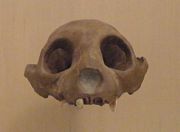
Archaeolemur
Encyclopedia
Archaeolemur is an extinct genus of lemur
s that includes two species, Archaeolemur edwardsi and A. majori.
The genus was widespread throughout Madagascar
through much of the Holocene
epoch, and its remains are often abundant at fossil
sites across the island. The wide geographical and temporal range of the genus may be attributed its generalist
nature. Archaeolemur was a semiterrestrial quadruped that spent much of its time on the ground, although it was also well suited to arboreal locomotion
. Despite its tendency for a mostly terrestrial lifestyle, it was not as well suited for cursorial
locomotion as macaque
s or baboon
s, the extant primates the genus is often compared to. When compared to highly terrestrial baboons, Archaeolemur had shorter, more robust limbs, smaller digits, and a wider trunk. Its diet is thought to have encompassed a wide range of foods including seeds and savanna plants. The incisors of Archaeolemur were enlarged and adapted to remove hard shells and rinds from seeds and fruit. The eurytopic adaptation of Archaeolemur may explain why it was one of the last of the subfossil lemurs to have gone extinct. It disappeared from Madagascar around 1047–1280 CE
.

Lemur
Lemurs are a clade of strepsirrhine primates endemic to the island of Madagascar. They are named after the lemures of Roman mythology due to the ghostly vocalizations, reflective eyes, and the nocturnal habits of some species...
s that includes two species, Archaeolemur edwardsi and A. majori.
The genus was widespread throughout Madagascar
Madagascar
The Republic of Madagascar is an island country located in the Indian Ocean off the southeastern coast of Africa...
through much of the Holocene
Holocene
The Holocene is a geological epoch which began at the end of the Pleistocene and continues to the present. The Holocene is part of the Quaternary period. Its name comes from the Greek words and , meaning "entirely recent"...
epoch, and its remains are often abundant at fossil
Fossil
Fossils are the preserved remains or traces of animals , plants, and other organisms from the remote past...
sites across the island. The wide geographical and temporal range of the genus may be attributed its generalist
Generalist and specialist species
A generalist species is able to thrive in a wide variety of environmental conditions and can make use of a variety of different resources . A specialist species can only thrive in a narrow range of environmental conditions or has a limited diet. Most organisms do not all fit neatly into either...
nature. Archaeolemur was a semiterrestrial quadruped that spent much of its time on the ground, although it was also well suited to arboreal locomotion
Arboreal locomotion
Arboreal locomotion is the locomotion of animals in trees. In every habitat in which trees are present, animals have evolved to move in them. Some animals may only scale trees occasionally, while others are exclusively arboreal. These habitats pose numerous mechanical challenges to animals...
. Despite its tendency for a mostly terrestrial lifestyle, it was not as well suited for cursorial
Cursorial
Cursorial is a biological term that describes an organism as being adapted specifically to run. It is typically used in conjunction with an animal's feeding habits or another important adaptation. For example, a horse can be considered a "cursorial grazer", while a wolf may be considered a...
locomotion as macaque
Macaque
The macaques constitute a genus of Old World monkeys of the subfamily Cercopithecinae. - Description :Aside from humans , the macaques are the most widespread primate genus, ranging from Japan to Afghanistan and, in the case of the barbary macaque, to North Africa...
s or baboon
Baboon
Baboons are African and Arabian Old World monkeys belonging to the genus Papio, part of the subfamily Cercopithecinae. There are five species, which are some of the largest non-hominoid members of the primate order; only the mandrill and the drill are larger...
s, the extant primates the genus is often compared to. When compared to highly terrestrial baboons, Archaeolemur had shorter, more robust limbs, smaller digits, and a wider trunk. Its diet is thought to have encompassed a wide range of foods including seeds and savanna plants. The incisors of Archaeolemur were enlarged and adapted to remove hard shells and rinds from seeds and fruit. The eurytopic adaptation of Archaeolemur may explain why it was one of the last of the subfossil lemurs to have gone extinct. It disappeared from Madagascar around 1047–1280 CE
Common Era
Common Era ,abbreviated as CE, is an alternative designation for the calendar era originally introduced by Dionysius Exiguus in the 6th century, traditionally identified with Anno Domini .Dates before the year 1 CE are indicated by the usage of BCE, short for Before the Common Era Common Era...
.
Classification

- Order PrimatePrimateA primate is a mammal of the order Primates , which contains prosimians and simians. Primates arose from ancestors that lived in the trees of tropical forests; many primate characteristics represent adaptations to life in this challenging three-dimensional environment...
s- Suborder StrepsirrhiniStrepsirrhiniThe clade Strepsirrhini is one of the two suborders of primates. Madagascar's only non-human primates are strepsirrhines, and others can be found in southeast Asia and Africa...
: non-tarsier prosimians- Infraorder Lemuriformes
- Family †Archaeolemuridae
- Genus †Archaeolemur
- Species †Archaeolemur edwardsi
- Species †Archaeolemur majori
- Genus †HadropithecusHadropithecusHadropithecus is a medium-sized, extinct genus of lemur, or strepsirrhine primate, from Madagascar that includes a single species, Hadropithecus stenognathus. Due to its rarity and lack of sufficient skeletal remains, it is one of the least understood of the extinct lemurs...
- Genus †Archaeolemur
- Family CheirogaleidaeCheirogaleidaeCheirogaleidae is the family of strepsirrhine primates that contains the various dwarf and mouse lemurs. Like all other lemurs, cheirogaleids live exclusively on the island of Madagascar.-Characteristics:...
: dwarf and mouse lemurs - Family Daubentoniidae: Aye-aye
- Family IndriidaeIndriidaeThe Indriidae are a family of strepsirrhine primates. They are medium to large sized lemurs with only four teeth in the toothcomb instead of the usual six...
: woolly lemurs and allies - Family LemuridaeLemuridaeLemuridae is a family of prosimian primates native to Madagascar, and one of five families commonly known as lemurs. These animals were thought to be the evolutionary predecessors of monkeys and apes, but this is no longer considered correct...
: lemurs - Family Lepilemuridae: sportive lemurs
- Family †Megaladapidae
- Family †Palaeopropithecidae
- Family †Archaeolemuridae
- Infraorder LorisiformesLorisiformesLorisiformes are a group of primates found throughout Africa and Asia. Members of this infraorder include the galagos and the lorises. As strepsirrhines, they are related to the lemurs.* Order Primates** Suborder Strepsirrhini: non-tarsier prosimians...
: lorises, pottos, galagos and allies
- Infraorder Lemuriformes
- Suborder HaplorrhiniHaplorrhiniThe haplorhines, the "dry-nosed" primates , are members of the Haplorhini clade: the prosimian tarsiers and the anthropoids...
: tarsiers, monkeys and apes
- Suborder Strepsirrhini

